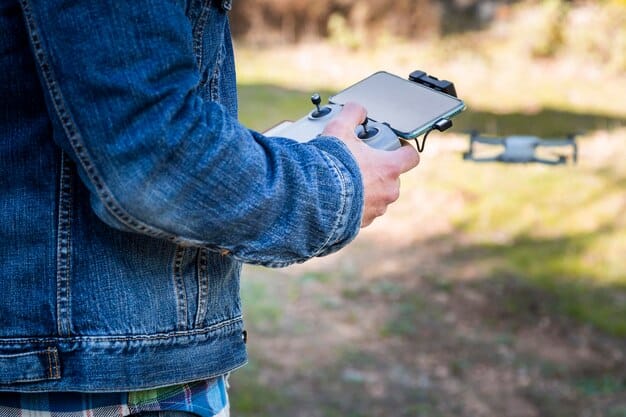Drone Technology in 2025: US Advancements and Regulations

Drone technology in the US is rapidly evolving, with 2025 poised to bring advancements in drone capabilities, alongside updated regulations addressing safety, privacy, and airspace management.
The landscape of Drone Technology: Exploring the Latest Advancements and Regulations in the US for 2025 is undergoing a significant transformation. As we approach 2025, it’s crucial to understand the emerging trends and the regulatory framework shaping the use of drones in the United States.
Drone technology: latest breakthroughs in the US
Drone technology is advancing at an unprecedented pace. New innovations are constantly emerging, transforming how drones are used across various sectors in the United States. From enhanced capabilities to groundbreaking applications, let’s delve into some of the most exciting breakthroughs.
Enhanced battery Life and Flight Range
One of the key areas of advancement is battery technology. Researchers are developing new batteries that offer significantly longer flight times and increased range, making drones more practical for long-distance applications.
Improved Sensor Technology
Advancements in sensor technology are enabling drones to collect more detailed and accurate data. High-resolution cameras, LiDAR systems, and thermal sensors are becoming more common, expanding the capabilities of drones in sectors like agriculture, construction, and environmental monitoring.
- Precision Agriculture: Drones equipped with advanced sensors can monitor crop health, identify areas needing irrigation, and optimize fertilizer application, leading to increased yields and reduced resource consumption.
- Infrastructure Inspection: Drones can safely and efficiently inspect bridges, power lines, and other critical infrastructure, identifying potential problems before they become major issues.
- Environmental Monitoring: Drones are being used to monitor deforestation, track wildlife populations, and assess the impact of pollution, providing valuable data for conservation efforts.
These advancements are not only improving the performance of drones but also opening up new possibilities for their use in various industries. As technology continues to evolve, we can expect even more impressive breakthroughs in the years to come.
Evolving drone regulations in the US
As drone technology advances, regulations are continuously updated to ensure safety, security, and privacy. Understanding the current regulatory landscape is essential for anyone operating drones in the United States in 2025. Here’s what you need to know.
FAA Regulations and Compliance
The Federal Aviation Administration (FAA) is the primary regulatory body for drones in the US. The FAA sets the rules for drone registration, pilot certification, and operational restrictions.
Remote ID Requirements
One of the most significant recent regulations is the Remote ID requirement, which mandates that all drones operating in US airspace must be identifiable remotely. This helps authorities track drones and ensure compliance with regulations.

- Part 107 Certification: Commercial drone operators must obtain a Part 107 certificate from the FAA, which requires passing an aeronautical knowledge test.
- Night Operations: Recent changes to the rules allow for night operations with proper training and lighting.
- Waivers and Authorizations: The FAA can grant waivers for certain operational restrictions, such as flying beyond visual line of sight (BVLOS), under specific conditions.
Staying informed about these evolving regulations is crucial for legal and safe drone operations. Regularly checking the FAA website for updates and seeking guidance from drone industry experts can help ensure compliance.
Drone applications across various industries
Drones are revolutionizing industries across the United States. Their versatility and efficiency make them invaluable tools in sectors ranging from agriculture to public safety. Let’s explore some of the most impactful applications.
Agriculture and Farming
In agriculture, drones are used for crop monitoring, field mapping, and precision spraying. This technology helps farmers optimize resource use, improve crop yields, and reduce environmental impact.
Construction and Infrastructure
Drones are transforming construction and infrastructure management by providing aerial surveys, progress monitoring, and inspection services. They can quickly and safely assess construction sites, bridges, and other critical infrastructure.

- Real Estate: Drones provide stunning aerial footage for property listings, giving potential buyers a unique perspective.
- Delivery Services: Drone delivery services are becoming increasingly common, offering fast and efficient transportation of goods, especially in urban areas.
- Search and Rescue: Drones equipped with thermal cameras are used in search and rescue operations to locate missing persons in challenging environments.
The diverse applications of drones are driving innovation and efficiency across various industries. As technology continues to advance, we can expect even more creative and impactful uses for drones in the future.
Security and privacy concerns with drone technology
While drone technology offers numerous benefits, it also raises significant security and privacy concerns. Addressing these issues is crucial for ensuring responsible and ethical drone use in the United States. Let’s examine some of the key challenges and potential solutions.
Data Security and Cyber Threats
Drones collect vast amounts of data, including images, videos, and location information. Protecting this data from cyber threats and unauthorized access is essential.
Privacy Issues and Surveillance
The ability of drones to conduct surveillance raises concerns about privacy violations. Regulations and best practices are needed to prevent drones from being used for intrusive monitoring or harassment.
Counter-Drone Technology
The rise of drones has also led to the development of counter-drone technology, which is used to detect, track, and neutralize unauthorized drones. This technology is becoming increasingly important for protecting critical infrastructure and sensitive areas.
Addressing these concerns requires a multi-faceted approach, including robust data security measures, clear privacy regulations, and the development of effective counter-drone systems. By prioritizing security and privacy, we can harness the benefits of drone technology while minimizing potential risks.
Future trends in drone technology
The future of drone technology is full of promise, with exciting developments on the horizon. From autonomous flight to advanced AI capabilities, here’s a glimpse into what we can expect in the coming years.
Autonomous Flight and AI Integration
Drones are becoming increasingly autonomous, capable of performing complex tasks with minimal human intervention. AI integration is enhancing their ability to analyze data, make decisions, and adapt to changing conditions.
Urban Air Mobility (UAM)
Urban Air Mobility (UAM) is an emerging concept that envisions using drones for passenger transport in urban areas. While still in its early stages, UAM has the potential to revolutionize urban transportation.
Drone Swarms
Drone swarms, where multiple drones work together to accomplish a task, are becoming more sophisticated. This technology has applications in areas such as agriculture, construction, and search and rescue.
These future trends are set to transform various industries and create new opportunities for drone technology. As innovation continues, we can expect even more groundbreaking developments that will shape the future of drones.
Best practices for responsible drone operation
Responsible drone operation is essential for ensuring safety, compliance, and community acceptance. Following best practices can help drone operators minimize risks and maximize the benefits of this technology. Let’s explore some guidelines.
Pre-Flight Checklist
Before each flight, conduct a thorough pre-flight checklist to ensure that the drone is in proper working condition and that all necessary permits and authorizations are in place.
Adherence to Regulations
Always adhere to FAA regulations and local ordinances. Stay informed about any changes to the rules and comply with all operational restrictions.
Community Engagement
Engage with the community to address any concerns and promote responsible drone use. Communicate openly about your operations and be respectful of privacy and property rights.
By following these best practices, drone operators can contribute to a safe, responsible, and sustainable drone ecosystem. Promoting ethical and compliant drone use is crucial for realizing the full potential of this technology.
| Key Point | Brief Description |
|---|---|
| 🚀 Drone Advancements | Battery life, sensor tech improve drone capabilities. |
| 📜 FAA Regulations | Remote ID, Part 107, and night operations compliance. |
| 💼 Industry Applications | Agriculture, construction, and delivery services benefit. |
| 🛡️ Security & Privacy | Addressing data security, surveillance, and counter-drone measures. |
Frequently Asked Questions
▼
The main advancements include lithium-ion batteries and solid-state batteries, offering longer flight times, higher energy density, and improved safety compared to traditional batteries.
▼
The FAA regulates drone operations through Part 107, requiring registration, pilot certification, and compliance with operational restrictions such as altitude and airspace limitations.
▼
Drones are used in agriculture for crop monitoring, precision spraying, field mapping, and assessing crop health, optimizing resource use and improving yields for farmers.
▼
Key security concerns include data breaches, unauthorized surveillance, and potential use of drones for malicious activities, requiring robust cybersecurity measures and regulations.
▼
Future trends include autonomous flight, AI integration, urban air mobility, and drone swarms, which will transform various industries and create new opportunities for drone technology.
Conclusion
As we look forward to 2025, drone technology is poised for remarkable advancements and evolving regulations in the US. By staying informed and adhering to best practices, we can harness the power of drones while ensuring safety, security, and privacy.





